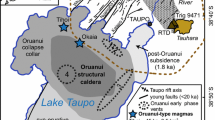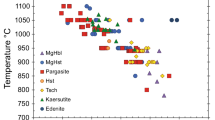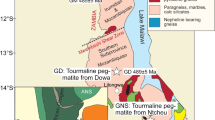Abstract
This paper presents a method for the systematic trace element modelling of a cogenetic suite of lavas. It is based on the geochemical inversion technique of Allègre and coworkers and utilizes the variations in the trace element concentrations of the lavas to calculate initial concentrations and source mineralogy. We reduce this inversion to a simple, step-by-step procedure: (1) correcting for fractional crystallization; (2) testing the inferred primary melt compositions for consistency with a model of equilibrium partial melts (with constant partition coefficients) formed from identical sources; (3) estimating the proportions of mineral phases entering the melt; (4) computing concentrations and bulk partition coefficients in the initial source relative to the concentration of a common reference element; (5) estimating relative mineral abundances in the source. Except for the fractionation correction, the calculations are done element by element using a direct analytic solution. For the purpose of comparison we apply this method to the same set of data used by Minster and Allègre (1978), a suite of lavas from Grenada (lesser Antilles) originally analyzed by Shimizu and Arculus (1975). The results of both methods agree well for the source abundances of the light REE, whereas the heavy REE abundances are shown to be poorly constrained by the data. Both methods require residual clinopyroxene and garnet in the source, but the ratio of these minerals is not well constrained. We are unable to reproduce the shape of D0 pattern (=bulk partition coefficients of the initial source) given by Minster and Allègre. The reason for this cannot be evaluated without repeating their calculations in detail.
The set of data from Grenada is useful for comparison of the methods only, because it is now known from isotopic data that the samples are not truly cogenetic. Possibly better suited sets of samples for petrogenetic modelling are presented in parts II and III of this series.
Similar content being viewed by others
References
Allègre CJ, Treuil M, Minster J-F, Minster B, Albarède F (1977) Systematic use of trace elements in igneous processes. Part I: Fractional crystallization processes in volcanic suites. Contrib Mineral Petrol 60:57–75
Allègre CJ, Minster J-F (1978) Quantitative models of trace element behavior in magmatic processes. Earth Planet Sci Lett 38:1–25
Bryan WB, Thompson G, Michael PJ (1979) Compositional variation in a steady-state zoned magma chamber: Mid-Atlantic Ridge at 36° N. Tectonophys 55:63–85
Hart SR, Davis KE (1978) Nickel partitioning between olivine and silicate melt. Earth Planet Sci Lett 40:203–219
Hawkesworth CJ, O'Nions RK, Arculus RJ (1979) Nd and Sr isotope geochemistry of island arc volcanics, Grenada, Lesser Antilles. Earth Planet Sci Lett 45:237–248
Irvine TN (1979) Rocks whose composition is determined by crystal accumulation and sorting. In: Yoder HS Jr (ed) The evolution of the Igneous Rocks, Fiftieth Anniversary Perspectives. Princeton University Press, ch 9:245–306
Minster J-F, Minster JB, Treuil M, Allègre CJ (1977) Systematic use of trace elements in igneous processes. Part II: Inverse problem of fractional crystallization in volcanic suites. Contrib Mineral Petrol 61:49–77
Minster J-F, Allègre CJ (1978) Systematic use of trace elements in igneous processes. Part III: Inverse problem of batch partial melting in volcanic suites. Contrib Mineral Petrol 68:37–52
O'Hara MJ (1977) Geochemical evolution during fractional crystallization of a periodically refilled magma chamber. Nature 266:503–507
Provost A, Allègre CJ (1979) Process identification and search for optimal differentiation parameters from major element data — general presentation with emphasis on fractional crystallization process. Geochim Cosmochim Acta 43:487–501
Shaw DM (1970) Trace element fractionation during anatexis. Geochim Cosmochim Acta 34:237–243
Shimizu N, Arculus RJ (1975) Rare earth element concentrations in a suite of basanitoids and alkali olivine basalts from Grenada, Lesser Antilles. Contrib Mineral Petrol 50:231–240
Treuil M, Joron JL (1975) Utilisation des éléments hygromagmatophiles pour la simplification de la modélisation quantitative des processus magmatiques. Exemples de l'Afar et de dorsale médio-Atlantique. Soc Ital Mineral Petrol 31:125–174
Wright TL, Doherty PC (1970) A linear programming and least squares computer method for solving petrologic mixing problems. Bull Geol Soc Am 81:1995–2008
Author information
Authors and Affiliations
Rights and permissions
About this article
Cite this article
Hofmann, A.W., Feigenson, M.D. Case studies on the origin of basalt. Contr. Mineral. and Petrol. 84, 382–389 (1983). https://doi.org/10.1007/BF01160289
Received:
Accepted:
Issue Date:
DOI: https://doi.org/10.1007/BF01160289




